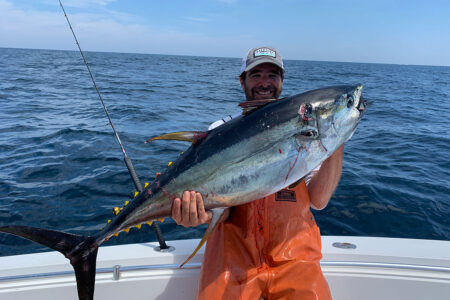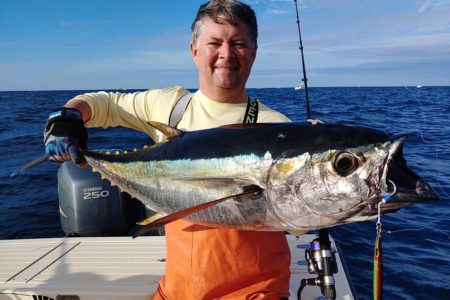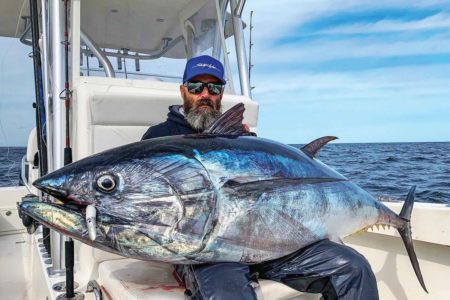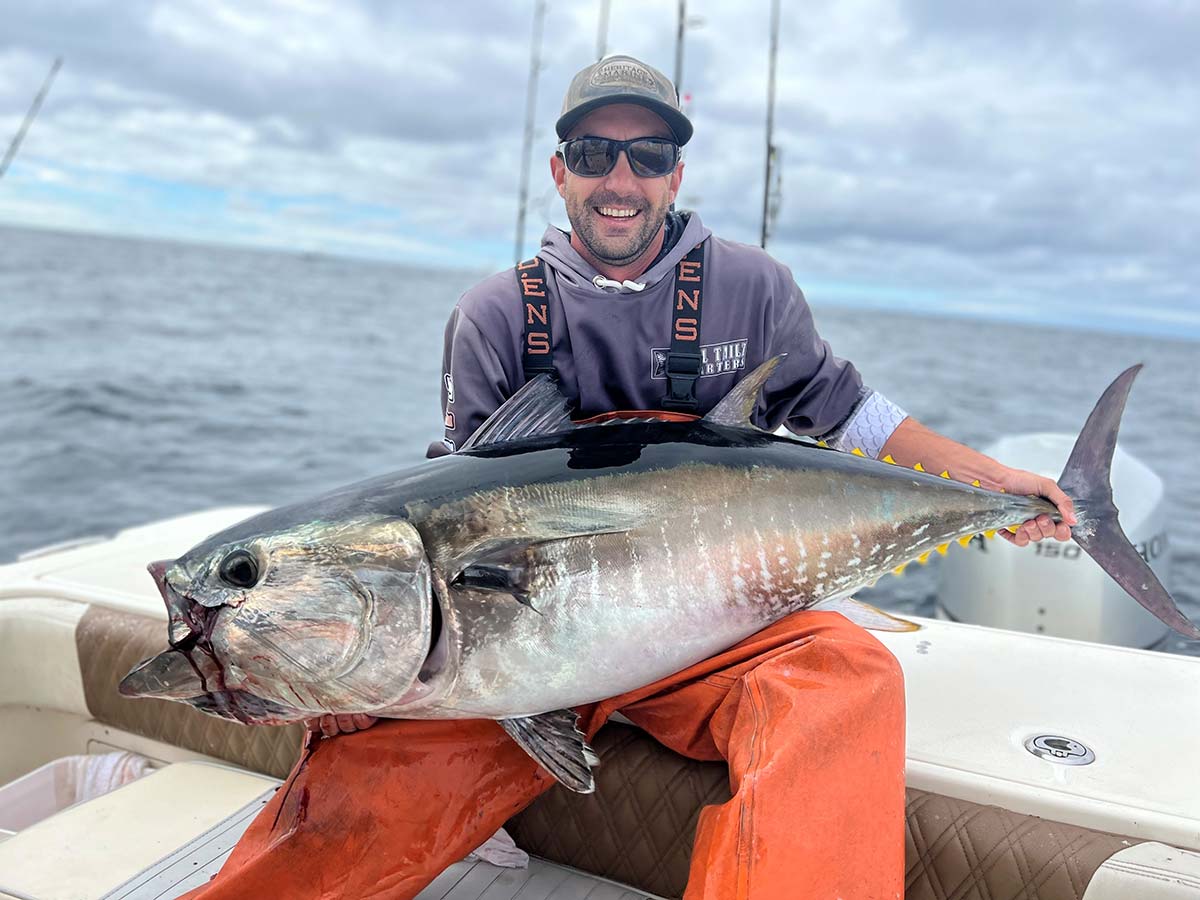
World class tuna fishing with a shorter ride!
If you’re a saltwater fisherman anywhere from Long Island to Cape Cod, you’ve probably heard offshore anglers using the term “south of Block” to describe where they fished. For some, this can be a vague and useless term. The nearshore waters or ‘middle grounds’ just south of Block Island offer some incredible fishing opportunities, without having to travel too far from home. This gives the typical inshore fisherman a chance to check some exotic species off their bucket list each summer. These nearshore grounds could be anywhere from 20 to 50 miles from the island, is what I consider the south of Block headquarters.
If you continue south, another 40 to 60 miles, you’ll hit the Gulf Stream, running along the edge of the northeast canyons. It’s this warm water current that brings with it a magnitude of life, filling our south of Block waters with many species of pelagics and baitfish. Warm water eddies and current pockets branch off from the Gulf Stream, creating ideal avenues for pelagic species to travel and hunt. These branches of warm water can extend as far north as Block Island Sound. With the right preparation and some basic knowledge, you can have some very rewarding days while still getting back to the dock in time for happy hour.
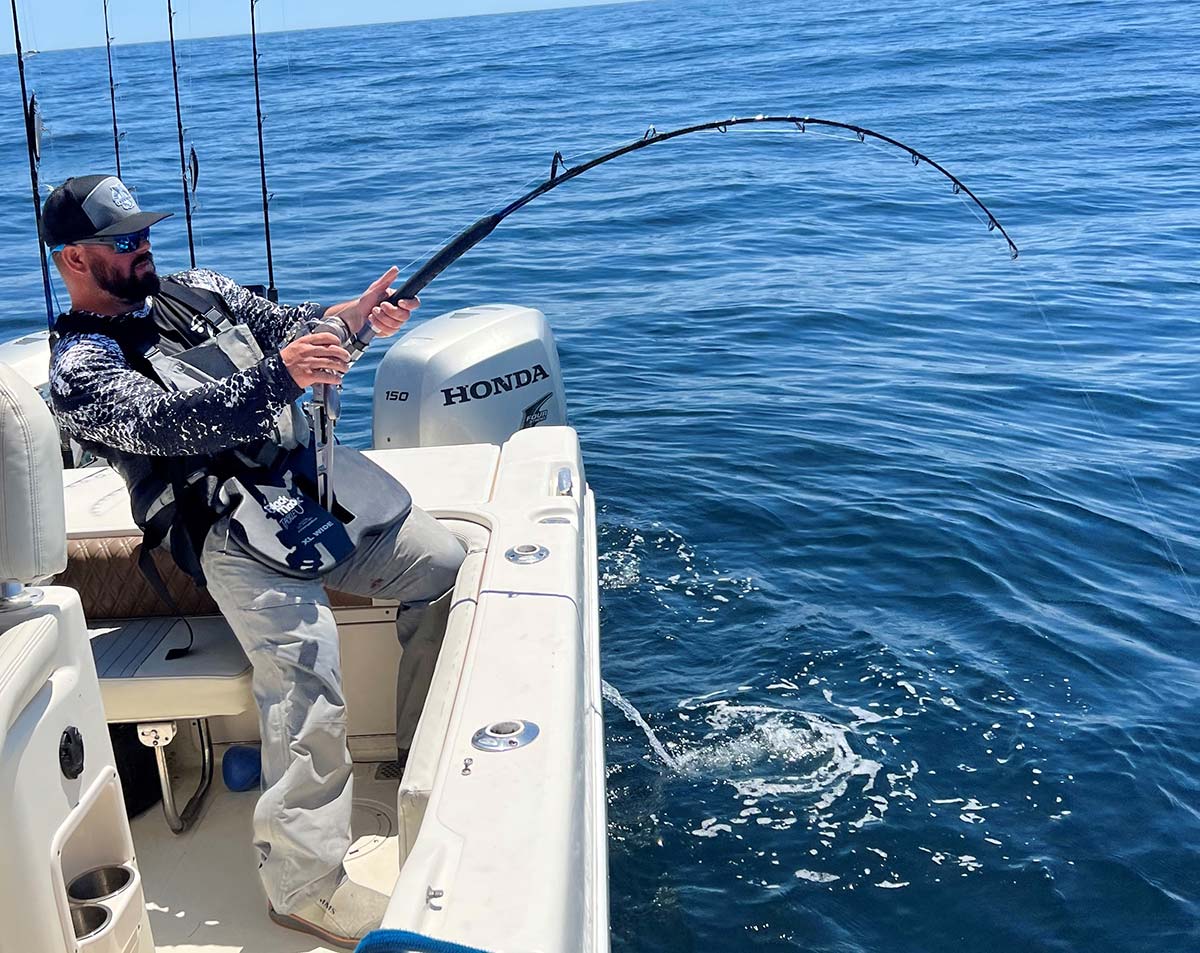
Striking Distance
Fishing south of Block for tuna isn’t some new wave phenomenon. These fish have been transiting this area for decades, probably centuries. A good starting point I like is called the ‘30-fathom line’, or as some old timers call it, the blood line. This nickname is specific to bluefin tuna as they typically follow this contour line from the southwest every year. This contour is roughly 170 to 200 feet deep. You can start just south of Block Island and head east or west, hitting several promising pieces of structure along the way. For example, starting from the windmills, southeast of the island, you’re within 20 to 30 miles of popular spots like the Gully, Tuna Ridge, the Suffolk Wreck, Coxes Ledge, CIA Grounds, Butterfish Hole, the Horns, and the Northeast and Northwest corners of the Dump. Continuing just a bit further south you’ll hit the shipping lanes which I consider to be the southern limits or “back end” of the nearshore grounds.
Having a set starting point and a game plan is important, but your most crucial tool, hands down, is having the right intel. Building a solid network of likeminded fishermen will keep you and your buddies on the fish. If you’re just starting out, go to your local tackle shop and extract as much info as you can. Join various social media groups and follow other fishermen to try and stay up to date on the bite. Make friends at the dock or the boat ramp, perhaps offering some persuasive beers to help pry some secrets out! All this will combine to contribute to helping you stay dialed in on the fish.
Ready For Anything
Preparation is key. You may only get a handful of good weather days each year. On these trips you’re going to cover some ground, burn some fuel and be on your own. You’ll want to take steps to ensure that you have everything you need on board. I love jig and pop style tuna fishing. I make sure I check all the boxes off for the spinning game, as that’s always my go to strategy. I bring four to six spinning setups equipped with reels in sizes ranging from 10K to 20K. My tackle bag is loaded with topwater offerings like wide mouth poppers, surface sliders, stick baits, soft plastics like Ron-Z’s, paddle tails and even Storm Shads. If the fish are holding deeper, I’ll deploy jigs from 50 to 400 grams of varying shapes and sizes to make sure we can get down to the fish. I always check my terminal tackle prior to any tuna trip. I’ll change leaders, hooks, split rings and swivels as necessary. I also roll with backups of absolutely everything. The last thing you want is to lose the go to lure of the day, without having a spare or two.
While I prefer the spin game, sometimes the tuna prefer a trolled offering. When covering ground and looking for fish I will occasionally put a trolling spread out to entice a bite. I run a simple trolling spread most of the time. I find what works and stick with it. Running a modest six rod spread, I like side trackers of varying colors on the outside, 120 to 150 feet, spreader bars on the short rigger just inside at 60 to 80 feet, with my two flat lines usually on a daisy chain or a Nomad DTX from 20 to 40 feet. Often, I’ll add a single skirted “shotgun” bait behind everything, usually an Iland lure or Joe Schute with a rigged ballyhoo. I like to keep my spreads simple and easy to clear, since I’m usually only fishing them to find the schools and hopefully adjust to a jig and pop approach.
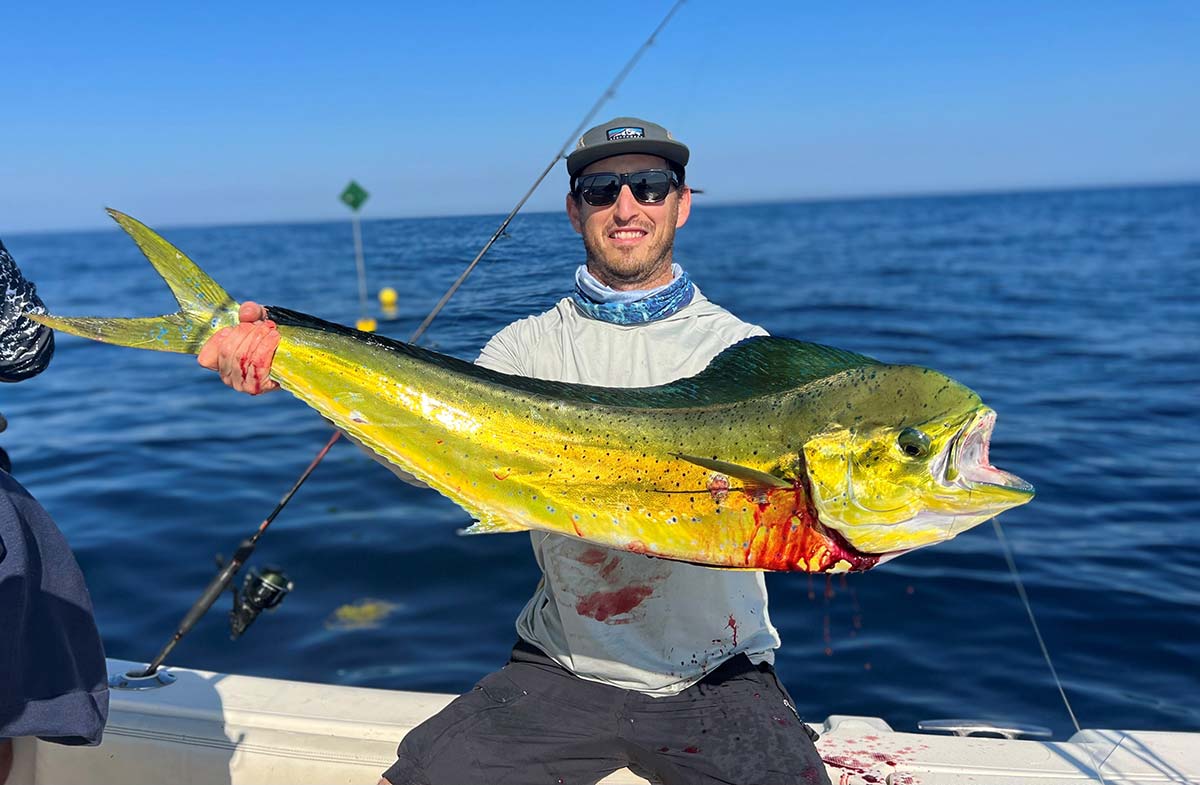
Charting Success
With the gear rigged and ready the next step is to form a specific game plan. Take the intel you’ve gathered and apply it to another crucial piece of data, sea surface temperature and chlorophyll charts. Companies like Roffs, FishTrack and RipCharts all offer up to date sea surface and chlorophyll charts via satellite imagery. If you want to increase your chances of finding fish, I highly recommend downloading a chart the night before your trip. Distinct temperature breaks are what you’re looking for. When the warmer and cleaner offshore “blue” water meets the dirtier inshore “green” water, it creates a perfect platform for life. The break in temperature is also where you’ll find high concentrations of chlorophyll. The chlorophyll is the primary food source for phytoplankton, which in turn, attract the smaller baitfish.
Where there are ample baitfish there will usually be ample tuna, as well as other pelagic species. The method is simple: mark a few promising temperature breaks and head out looking for life. Where there is this much food, you’ll find all ranks of the food chain ringing the dinner bell. Be on the lookout for whales and porpoises. Feeds tend to happen all at once. If you see whales bubble feeding and porpoises working a tight area, chances are very high tuna are mixed in or beneath them. Keep an eye on your sounder and note when you see a sharp change in temperature. In almost all cases, if you find the break, you find the life, and ultimately find the tuna.
Contingency Pays
As excited and prepared as you might be, sometimes the bite simply shuts down. A cold front or new lunar cycle might stall the action. While run and gun bluefin tuna and yellowfin tuna is the goal, I always come prepared for a plan B, C and D. If you’re in warm water, I always keep a lookout for surface structure. Highflyer buoys, weed lines and floating debris are like gold. Most times, these isolated pieces of structure will hold mahi-mahi. I bring a few inshore spinning rods with me to chunk and drift butterfish or squid. Simply casting epoxy jigs to the mahi will often produce as well. If you can get one to bite, it can trigger a frenzy, and you can fill the box in no time. I also like to make a few deep trolling passes along larger weed lines for wahoo. I really like Nomad DTX minnows and Mad Macs when making these quick passes. If we’re hammering mahi and don’t want to troll, I’ll drop down a jig in hopes of finding a hungry wahoo as well. Often, these predators will stalk unsuspecting prey from deep below the floating structure.
The final back up plan, is to be on the lookout for white marlin on the surface. If you see bait erratically spraying out of the water, keep your eyes glued! White marlin will coral large bait balls at the surface to collect their next meal. You will literally see the bills and tails of the marlin coming out of the water after the bait. I’ve witnessed some incredible scenes while running around south of Block. I like to throw live eels or Ron-Z’s to surface feeding whites with a quick retrieve. This is a “right place, right time” type scenario, but you don’t want to be unprepared when the opportunity presents itself!
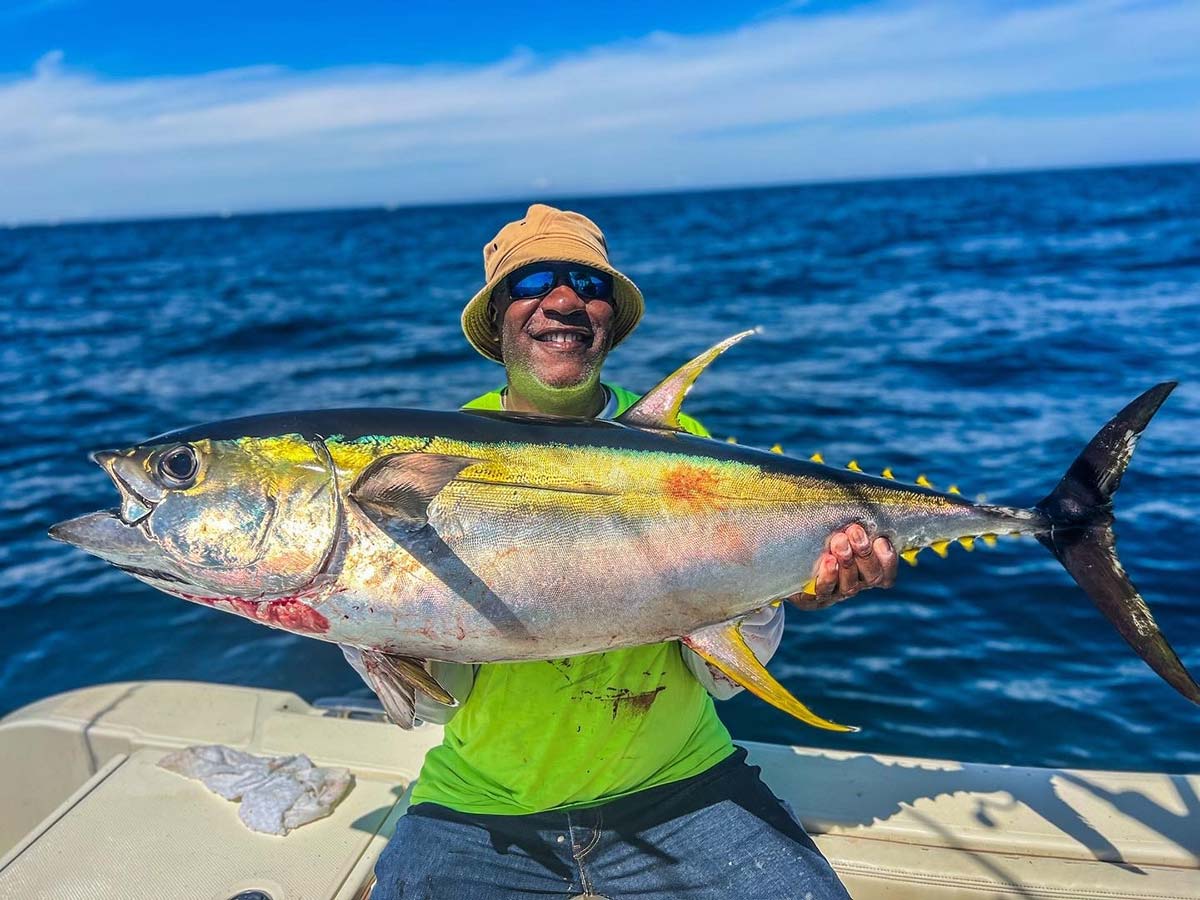
Yellow & Blue
The past two years have been unique in that there has been a fantastic push of very warm water to the 30-fathom line and beyond. This has created a very consistent bite for most of the summer. While catching a few yellowfin tuna that far inshore isn’t unheard of, the consistency in the past few years has been pretty historic. With global water temperatures slowly rising I’m hoping this will be a repeating trend. Anglers don’t have to go all the way to the canyons for action packed days with shots at bluefin and yellowfin tuna.
We’re very fortunate to have this unique fishery right in our backyard. Most people don’t realize that we have such world class fishing this close to home. Always have a contingency plan to target other species in case the tuna decide to play hide and seek. Try to build a network of tuna fishing friends to stay in the know. If you do your homework and come prepared with a confident game plan, you might find Charlie the tuna fish, just south of Block.
